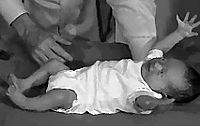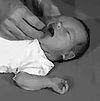- Primitive reflexes
-
Primitive reflexes are reflex actions originating in the central nervous system that are exhibited by normal infants but not neurologically intact adults, in response to particular stimuli. These reflexes disappear or are inhibited by the frontal lobes as a child moves through normal child development.[1] These primitive reflexes are also called infantile, infant or newborn reflexes.
Older children and adults with atypical neurology (for instance, people with cerebral palsy) may retain these reflexes and primitive reflexes may re-appear in adults because of certain neurological conditions including, but not limited to, dementia, traumatic lesions, and strokes.[2][3] An individual with cerebral palsy and typical intelligence can learn to suppress these reflexes, but the reflex might resurface under certain conditions such as during an extreme startle reaction. Reflexes may also be limited to those areas affected by the atypical neurology, such as individuals whose cerebral palsy affects only their legs retaining the Babinski reflex but having normal speech; in individuals with hemiplegia, the reflex might be seen in the foot on the affected side only.
Primitive reflexes are primarily tested with suspected brain injury to test the functioning of the frontal lobe. If they are not being suppressed properly they are called frontal release signs. Atypical primitive reflexes are also being researched as potential early warning signs of autistic spectrum disorders.[4]
Contents
Adaptive value of reflexes
Reflexes vary in utility. Some have a survival value. A perfect example would be the rooting reflex, which helps a breastfed infant find the mother's nipple. Babies display it only when hungry and touched by another person, not when they touch themselves. There are a few reflexes that probably helped babies survive during human evolutionary past like the Moro reflex. Other reflexes such as sucking and grabbing help establish gratifying interaction between parents and infants. They can encourage a parent to respond lovingly and feed more competently. They can also help parents comfort their infant because they allow the baby to control distress and the amount of stimulation they receive.[5]
Moro reflex
Main article: Moro reflexThe Moro reflex in a four-day-old infant: 1) the reflex is initiated by pulling the infant up from the floor and then releasing him ; 2) he spreads his arms 3) he pulls his arms in ; 4) he cries (10 seconds)
This is sometimes referred to as the startle reaction, startle response, startle reflex or embrace reflex. It is more commonly known as the Moro response or Moro reflex after its discoverer, pediatrician Ernst Moro.
The Moro reflex is present at birth, peaks in the first month of life and begins to disappear around 2 months of age. It is likely to occur if the infant's head suddenly shifts position, the temperature changes abruptly, or they are startled by a sudden noise. The legs and head extend while the arms jerk up and out with the palms up and thumbs flexed. Shortly afterward the arms are brought together and the hands clench into fists, and the infant cries loudly.[6] The reflex normally disappears by three to four months of age,[7] though it may last up to six months.[8] Bilateral absence of the reflex may mean damage to the infant's central nervous system while a unilateral absence could mean an injury due to birth trauma such as a fractured clavicle or injury to the brachial plexus. Erb's palsy or some other form of paralysis is also sometimes present in such cases.[7] In human evolutionary history, the Moro reflex may have helped the infant cling to his mother while she carried him around all day. If the infant lost its balance, the reflex caused the infant to embrace its mother and regain its hold on the mother’s body.[5]
Walking/stepping reflex
The walking or stepping reflex is present at birth; though infants this young can not support their own weight, when the soles of their feet touch a flat surface they will attempt to 'walk' by placing one foot in front of the other. This reflex disappears at 6 weeks due to an increased ratio of leg weight to strength[9]. It reappears as a voluntary behavior at around eight months to a year old.
Rooting reflex
The rooting reflex is present at birth; it assists in breastfeeding, disappearing at around four months of age as it gradually comes under voluntary control. A newborn infant will turn his head toward anything that strokes his cheek or mouth, searching for the object by moving his head in steadily decreasing arcs until the object is found. After becoming used to responding in this way (if breastfed, approximately three weeks after birth), the infant will move directly to the object without searching.
Sucking reflex
The sucking reflex is common to all mammals and is present at birth. It is linked with the rooting reflex and breastfeeding, and causes the child to instinctively suck at anything that touches the roof of their mouth and suddenly starts to suck simulating the way they naturally eat. There are two stages to the action:
- Expression: activated when the nipple is placed between a child's lips and touches their palate. They will instinctively press it between their tongue and palate to draw out the milk.
- Milking: The tongue moves from areola to nipple, coaxing milk from the mother to be swallowed by the child.
Tonic neck reflex
Main article: Asymmetrical tonic neck reflexThe tonic neck reflex, also known as asymmetric tonic neck reflex or 'fencing posture' is present at one month of age and disappears at around four months. When the child's head is turned to the side, the arm on that side will straighten and the opposite arm will bend (sometimes the motion will be very subtle or slight). If the infant is unable to move out of this position or the reflex continues to be triggered past six months of age, the child may have a disorder of the upper motor neurons. According to researchers, the tonic neck reflex is a precursor to the hand/eye coordination of the infant. It also prepares the infant for voluntary reaching.[5]
Palmar grasp reflex
The palmar grasp reflex appears at birth and persists until five or six months of age. When an object is placed in the infant's hand and strokes their palm, the fingers will close and they will grasp it. The grip is strong but unpredictable; though it may be able to support the child's weight, they may also release their grip suddenly and without warning. The reverse motion can be induced by stroking the back or side of the hand.
Plantar reflex
Main article: Plantar reflexA plantar reflex is a normal reflex that involves plantar flexion of the foot (toes move away from the shin, and curl down. An abnormal plantar reflex (aka Babinski Sign) occurs when upper motor neuron control over the flexion reflex circuit is interrupted. This results in a dorsiflexion of the foot (foot angles towards the shin, big toe curls up). This also occurs in babies under ~1 year, because of low myelination of the corticospinal tracts. As these tracts develop to adult form, the flexion-reflex circuit is inhibited by the descending corticospinal inputs, and the normal plantar reflex develops.[10]. Also known as the Babinski reflex, this is a sign of neurological abnormality, e.g. upper motor neurone lesion, in adults.[11]
Galant reflex
Main article: Galant reflexThe Galant reflex, also known as Galant’s infantile reflex, is present at birth and fades between the ages of four to six months. When the skin along the side of an infant's back is stroked, the infant will swing towards the side that was stroked. If the reflex persists past six months of age, it is a sign of pathology. The reflex is named after the Russian neurologist Johann Susman Galant.[12]
Swimming Reflex
An infant placed face down in a pool of water will begin to paddle and kick in a swimming motion. The reflex disappears between 4–6 months. Its survival function is to help the child stay alive if it is drowning so a caregiver has more time to save it. Although the infant will begin to paddle and kick, placing them in water is very risky. They swallow a large amount of water at the same time. It is advisable to postpone swimming lessons in infants until they are at least three months old.[5]
Babkin reflex
An infant demonstrating the Babkin reflex: he opens his mouth when pressure is applied to both palms (8 seconds).
The Babkin reflex occurs in newborn babies, and describes varying responses to the application of pressure to both palms. Infants may display head flexion, head rotation or opening of the mouth, or a combination of these responses[13]. Smaller, premature infants are more susceptible to the reflex, with an observed occurrence in a child of 26 weeks gestation.[14] It is named for Russian neurologist Boris Babkin.
Other primitive reflexes tested in adults
As mentioned these are generally referred to as frontal release signs although this may be a misnomer. They include the palmomental reflex, snout reflex, glabellar reflex or "tap", in addition to some of those mentioned above.
References
- ^ "Primitive & Postural Reflexes" (php). http://www.inpp.org.uk/reflexes/primitive_postural_reflexes.php. Retrieved 2008-10-23.
- ^ Rauch, Daniel (2006-10-05). "Infantile reflexes on MedLinePlus". MedlinePlus. http://www.nlm.nih.gov/medlineplus/ency/article/003292.htm. Retrieved 2007-10-11.
- ^ Schott JM, Rossor MN (2003). "The grasp and other primitive reflexes". J. Neurol. Neurosurg. Psychiatr. 74 (5): 558–60. doi:10.1136/jnnp.74.5.558. PMC 1738455. PMID 12700289. http://www.pubmedcentral.nih.gov/articlerender.fcgi?tool=pmcentrez&artid=1738455.
- ^ Teitelbaum O, Benton T, Shah PK, Prince A, Kelly JL, Teitelbaum P (2004). "Eshkol-Wachman movement notation in diagnosis: the early detection of Asperger's syndrome". Proc. Natl. Acad. Sci. U.S.A. 101 (32): 11909–14. doi:10.1073/pnas.0403919101. PMC 511073. PMID 15282371. http://www.pubmedcentral.nih.gov/articlerender.fcgi?tool=pmcentrez&artid=511073.
- ^ a b c d Berk, Laura E.. Child Development. 8th. USA: Pearson, 2009.
- ^ Alex Gray; The American Academy of Pediatrics; Stephen P. Shelov; Robert E. Hannemann; Wendy Wray (1998). Caring for Your Baby and Young Child: Birth to Age 5. London: Bantam. ISBN 0-553-37962-3.
- ^ a b Rauch, Daniel (MedlinePlus) (2006-10-05). "MedlinePlus Medical Encyclopedia: Moro Reflex". http://www.nlm.nih.gov/medlineplus/ency/article/003293.htm. Retrieved 2007-10-11.
- ^ "Keeping Kids Healthy: Newborn Reflexes". 2001-10-14. http://www.keepkidshealthy.com/newborn/newborn_reflexes.html. Retrieved 2007-10-11.
- ^ Siegler, R., Deloache, J., & Eisenberg, N. (2006). How Children Develop. New York: Worth Publishers. p. 188. ISBN 9780716795278.
- ^ Khwaja, JIACM 2005; 6(3): 193-7: "Plantar Reflex"
- ^ "Babinski's reflex". MedlinePlus. http://www.nlm.nih.gov/medlineplus/ency/article/003294.htm. Retrieved 11 January 2010.
- ^ "The Galant Reflex". http://www.whonamedit.com/synd.cfm/3306.html.
- ^ Fleming S. Pedroso, MD, PhD; Newra T. Rotta, MD, PhD (2004). "Babkin Reflex and Other Motor Responses to Appendicular Compression Stimulus of the Newborn". Journal of Child Neurology 19 (8): 592–596. doi:10.1177/088307380401900805. PMID 15605468. http://jcn.sagepub.com/cgi/content/abstract/19/8/592.
- ^ Arthur H. Parmelee Jr. M.D. (May 5, 1963). "The Hand-Mouth Reflex of Babkin in Premature Infants". Pediatrics 31 (5): 734–740. PMID 13941546. http://pediatrics.aappublications.org/cgi/content/abstract/31/5/734.
14 - Odent M. The early expression of the rooting reflex. Proceedings of the 5th International Congress of Psychosomatic Obstetrics and Gynaecology, Rome 1977. London: Academic Press, 1977: 1117-19.
External links
- "PediNeuroLogic Exam - Movies of infant reflex testing". http://library.med.utah.edu/pedineurologicexam/html/newborn_n.html. Retrieved 2007-10-11.
- "Medri Vodcast: Neonatology - Movies of the neurological examination of the newborn infant". http://phobos.apple.com/WebObjects/MZStore.woa/wa/viewPodcast?id=273409429. Retrieved 2008-05-02.
Nervous system physiology: neurophysiology - reflex Cranial nerve midbrain: Pupillary light reflex · Accommodation reflex
pons/medulla: Jaw jerk reflex · Corneal reflex · Caloric reflex test/Vestibulo-ocular reflex/Oculocephalic reflex · Pharyngeal (gag) reflexStretch reflexes upper limb: Biceps reflex C5/C6 · Brachioradialis reflex C6 · Triceps reflex C7/C8
lower limb: Patellar reflex L2-L4 · Ankle jerk reflex S1/S2 · Plantar reflex L5-S2Primitive reflexes Lists Cardiovascular Bainbridge reflex · Bezold-Jarisch reflex · Coronary reflex · Mammalian diving reflex · Oculocardiac reflexReflex bradycardia · Reflex tachycardiaRespiratoryChurchill-Cope reflexOther Acoustic reflex · H-reflex · Golgi tendon reflex · Optokinetic · Startle reaction · Withdrawal reflex (Crossed extensor reflex)Categories:- Reflexes
- Pediatrics
Wikimedia Foundation. 2010.






